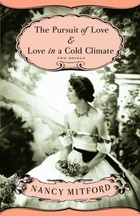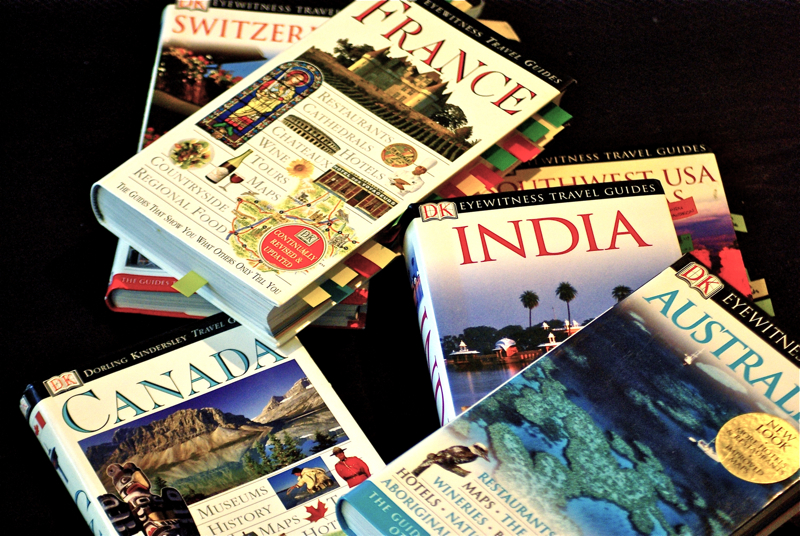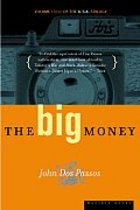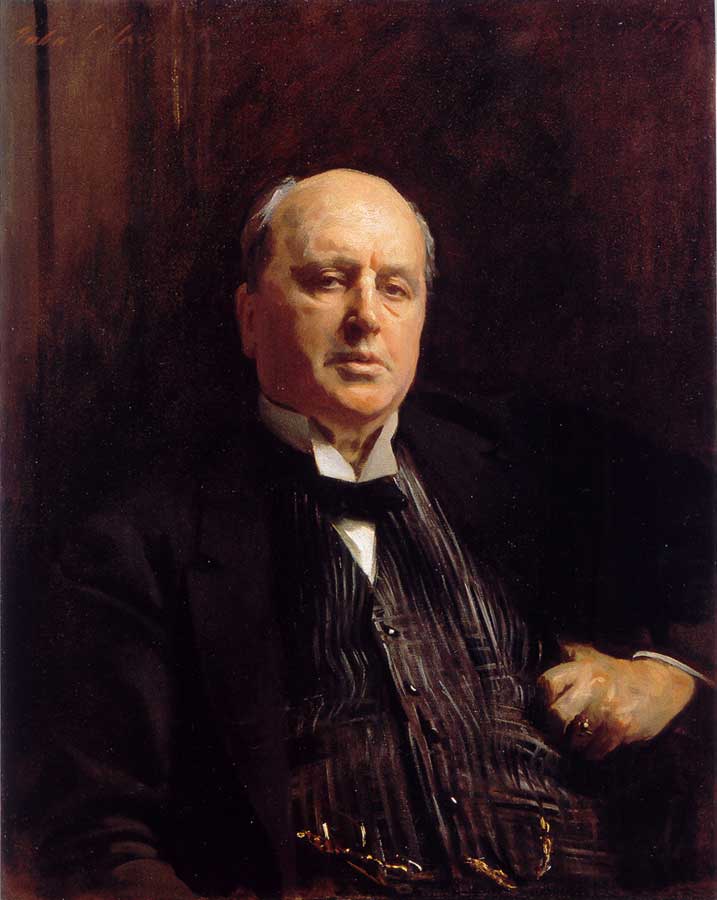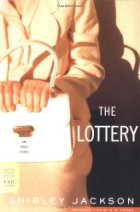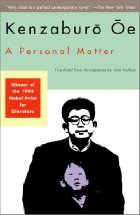
WARNING: May contain triggers for those who have experienced rape.
I've written before about how novellas sometimes sneak up on me, taking a while to build up and becoming truly engaging just as they're about to end. I suppose that one sure-fire way to avoid this syndrome is to start your novella like Kenzaburo Oe's A Personal Matter: full-throttle intensity from the first page, when the atmosphere of subtly grotesque alienation is already fully developed, and the reader seems to be thrust down into the midst of an interpersonal wound of a situation—one that that has obviously been festering for some time. Long before the protagonist Bird hears the news, on page 15, that there is something abnormal about the baby his wife has been laboring for hours to deliver, it's already plain that he perceives the world around him in a skewed and deeply estranged way. The most ordinary details around him, such as the "small and soiled" hands of a cashier, "the meagerness of her fingers recall[ing] chameleon legs clinging to a shrub," or the "mean sky that seemed ashamed, roughly violated by clouds like galloping shaggy dogs," suggest a grotesqueness, a fun-house quality that constantly prevents Bird from getting his bearings or even keeping his balance. His dreams are vivid and disturbing, and his life has the quality of a dream as well: seemingly stalled at an emotional age of about fourteen, he has somehow ended up married to a woman he seems hardly to know and to whom he feels little connection, with a job he dreams of chucking and fleeing to Africa, and he wakes up one morning after a fistfight with a gang of street toughs to discover that he is the father of baby with a severely malformed brain.
A Personal Matter is the story of a man's coming to terms with his deformed baby, but writing out the plot like that suggests a very different book than the one Oe has actually written. For one thing, it implies that Bird is a sympathetic character: who could withhold sympathy from a man who has just suffered such a horrendous blow? But in fact Oe's protagonist is deeply unsympathetic—a result, of course, of his own inability to feel love, connection, or sympathy with anyone around him. A more alienated (in the sociological sense) character I've seldom read: not only does Bird seem to lack any loyalty to or love for his wife, son, and family, but he has fantasies about extremely violent and taboo actions (like killing his mistress and raping her dead body, for example, not to mention the central conflict of the book: whether he will kill what he considers his "monster baby" or raise it as a son). Unsurprisingly, he also has the classic feeling of enacting a role, that all actions left to him are empty performances and that no mode of behavior has any "reality":
Bird turned around, as if to make certain of an escape route: paused along the dim corridor, young women in their nightgowns were peering at him through the dimness. Bird considered scowling back but he merely shook his head weakly and turned his back, then gave a timid knock at the door. He was performing the role of the young husband who has been visited by sudden misfortune.
But it's not just Bird. The whole society in which he lives is similarly alienated. His mother-in-law actively encourages Bird to lie to his wife (her daughter) about what's wrong with the baby, and to encourage it to weaken and die, because otherwise (as she says), her "little girl will never agree to have another child." Honesty and the mental health of the wife/daughter/mother take second place to the vague cultural mandate that a woman should produce multiple babies; the behavior I expect from a woman's own mother is turned on its head. Similarly, in one of the most grotesque scenes in the novella, the doctor at the hospital where Bird's baby is born refuses even to refer to him as an infant, instead scoffing when Bird announces that he is "the father," asking whether Bird wants to "see the goods" (meaning his son), and giggling as he informs the Bird that his son appears to have two heads. At every possible turn, the people in the society depicted desert, betray, and fail to connect with one another; and while this doesn't make Bird's behavior likable, it at least provides a context in which to place him. As much as I might be repulsed by Bird at times, it is hard to come up with a more logical or compassionate mode of behavior, when everyone around him is also so alienated and even vindictive.
Oe does a good job of keeping the onus of Bird's complexes and dubious behaviors on his own shoulders, while at the same time examining the external factors at play. It becomes plain, about halfway through the novella, that one of the main sources of this society-wide disorientation is the outcome of World War II and the role of the nuclear bomb in ending it. Set in 1961, and involving Kruschev's announcement of the Soviet resumption of nuclear testing which eventually led to the Cuban Missile Crisis, A Personal Matter is also dealing with an overtly political matter: the devastating consequences of 200,000 dead and a traditional way of life shattered, with no viable alternative yet developed. Bird and those around him continue to act their parts, perform their roles as more or less traditional members of society (marrying, having children) despite the fact that those roles have lost their power to provide meaningful self-definition for those who practice them. The people of Bird's generation have been defined by a huge event which they nevertheless were too young to actively affect or understand:
If he had ever been to war, Bird thought often, he would have been able to say definitely whether he was a brave type. This had occurred to him before fights and before his entrance examinations, even before his marriage. And always he had regretted not having a definite answer. Even his longing to test himself in the wilds of Africa which opposed the ordinary was excited by his feeling that he might discover in the process his own private war.
Bird is defined by war, but has never been to war; he has never grown up, but is somehow a father in his late 20s. As much as I was sometimes very put off by the violence and alienation of Bird's consciousness, I think I understood the root and necessity of them by the end of the novella. It was harder work to like this book than Oe's 1990 novel A Quiet Life (the only other book by him I've read), and definitely harder to like its protagonist, but in the end I found it at least equally powerful.
And speaking of A Quiet Life, the contrast between the two books was fascinating. One could argue that both novels are thinly-veiled autobiography, but the events of A Personal Matter take place thirty years earlier, and whereas the earlier work is told from a limited third-person perspective focused on the young Bird, the later one (narrated in first-person by the Bird-like character's daughter) presents him character at a vast remove, a delicate yet enigmatic father-figure whose for whose periodic breakdowns every character has a different explanation. The atmospheres of the two books, though similar in their masterful craftsmanship, are likewise radically different, for while Ma-Chan lives in a more or less benign environment (bad things happen, but her existence is more or less quiet and thoughtful), Bird's world is so fraught with menace that he can barely step outside without being threatened by something or someone. In A Quiet Life, the wild lack of any foothold has been replaced with a semi-distant but nonetheless caring, engaged family life, and the mystery behind Ma-chan's father's persistent melancholia is a somewhat intellectual one. On the contrary, Bird can hardly get his breath in his surroundings, let alone think calmly or selflessly enough to engage in a passionate conversation about Vonnegut or Céline. Although I was initially wary when I heard that Oe returns again and again, in his novels, to the theme of his brain-damaged son, I'm now very intrigued and eager to read more of his novels, to explore the different angles from which he approaches his repeated subject.
A Personal Matter was the July pick for the Non-Structured Book Group; join us in August for In the American Grain, by William Carlos Williams.
